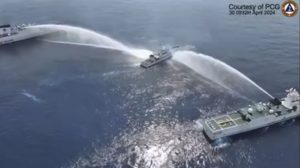On December 9 last year, the Philippine government announced that a China Coast Guard (CCG) ship had fired a water cannon at a Philippine vessel in the waters of the Spratly Islands in the South China Sea, over which there is an ongoing territorial dispute. The next day, it announced that a CCG ship fired a water cannon at a supply vessel carrying supplies for the Philippine navy and a Philippine Coast Guard (PCG) patrol vessel escorting it in the waters around the Second Thomas Shoal (Ayungin Shoal), which is effectively controlled by the Philippines.
In the East China Sea, meanwhile, intrusions by CCG ships into the Japanese territorial sea around the Senkaku Islands (which are claimed by China as the Diaoyu Islands) as well as the approaching and tracking of Japanese fishing vessels by CCG ships have become commonplace. The Japan Coast Guard takes measures against the CCG in accordance with international and Japanese laws.
The international law of the sea, which sets out the international legal norms for maintaining and building order at sea, has a long history. Concepts such as “freedom of the seas” and the right of innocent passage in territorial seas have been established as principles and rights under customary international law through the accumulated practices of countries. Today, the content of the international law of the sea is codified in the United Nations Convention on the Law of the Sea (UNCLOS), adopted in 1982.
However, China’s position is that UNCLOS does not govern all matters of the international law of the sea, so that its scope is “limited.” China is making the original claim that the “historical rights” it has within the nine-dashed line in the South China Sea were established prior to the adoption of UNCLOS and that UNCLOS cannot deny pre-established rights. This claim made by China was rejected by an international tribunal’s ruling in the South China Sea arbitration case in July 2016.
China’s Coast Guard Law (CCG Law), passed by the National People’s Congress in January 2021, stipulates what kind of institution the CCG is and what kind of authority it can exercise.
The stipulated geographical scope of the CCG Law is the “sea areas under the jurisdiction of the People’s Republic of China.” It is unclear from this stipulation how far the sea areas under Chinese jurisdiction extend, whether they correspond to the internal waters, territorial sea, contiguous zone, exclusive economic zone, and continental shelf – which UNCLOS recognizes that coastal states have sovereignty and jurisdiction over – or whether they extend to the sea areas that UNCLOS doesn’t recognize but China claims.
However, the draft version of the CCG Law did define the sea areas under Chinese jurisdiction as “internal waters, territorial sea, contiguous zone, exclusive economic zone, continental shelf, and other sea areas under the jurisdiction of the People’s Republic of China.” This means that China distanced itself from UNCLOS and added its own sea areas to those for which UNCLOS recognizes sovereignty and jurisdiction to coastal states.
The CCG is a maritime law enforcement agency, but the CCG Law also refers to “national sovereignty,” “national security,” and “defense.” The CCG Law stipulates that the CCG has the authority to take measures in situations where China’s sovereignty is violated, meaning it can conduct military activities.
The CCG Law provides for the “use of weapons” against acts that infringe on China’s “national sovereignty.” Depending on the situation, this may correspond to the “use of force” in international conflict. Under international law, the “use of weapons” and “use of force” are not the same. The “use of weapons” refers to the use of physical force to ensure the effectiveness of law enforcement activities, while the “use of force” refers to the use of physical force to destroy the military capacity of an enemy country as part of military activities. China is being deliberately ambiguous in stipulating the use of two kinds of force, which differ entirely in their position and purpose under international law.
The CCG is an agency that has both law enforcement and military authority. It is not possible for other parties to judge under which authority CCG ships are operating. Under international law, there is a difference between maritime law enforcement and military activities. The CCG seeks to gain a strategic advantage through this ambiguity by disrupting the judgment of the opposing side out in the field, causing delays in decision-making and responses. The “fog” on the front lines is becoming thicker and thicker.
At present, that countries confronting China in the seas of Asia are working to improve their maritime law enforcement capabilities through international cooperation and coordination. Asian countries are receiving growing assistance from the United States, Australia, and others.
Nonetheless, while maritime law enforcement activities contribute to national security by ensuring national sovereignty and independence as well as eliminating infringements of territorial sovereignty, these are only secondary effects. Law enforcement and military activities differ in purpose, legal basis, and their activities.
The coastal states confronting China at sea make clear the significance and scope of maritime law enforcement activities (what can and cannot be done), so that they can give maritime law enforcement activities their proper position and so that they can respond to situations pertaining to national security seamlessly, appropriately, and effectively.

































